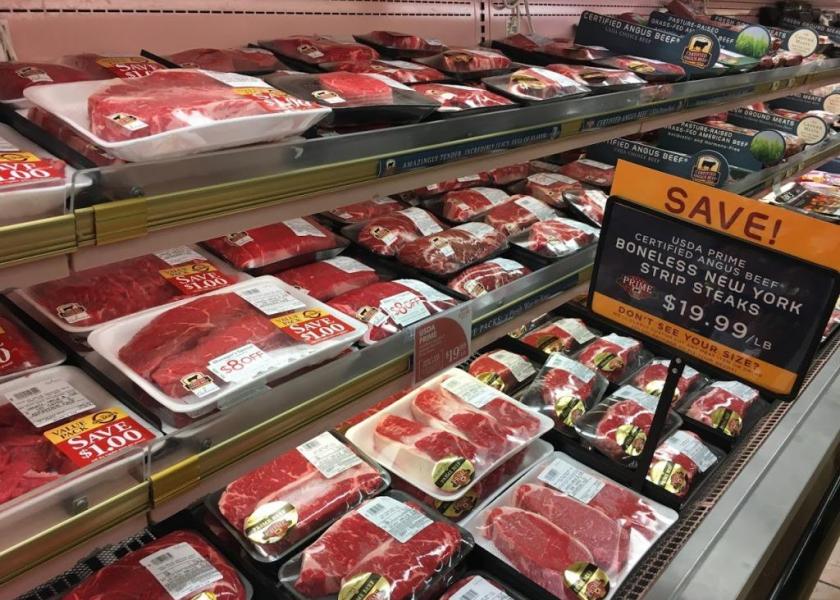CAB Insider: Lower Cutouts Spur Beef Buying

May is Beef Month and the push for sales in volume is underway, driven on the promise of spring grilling demand. Packers have increased production to the limit their labor resources will support, which means harvest levels larger than 665,000 head across all federally inspected plants. Total year-to-date beef harvest has run close to 2% larger, with fed cattle up 1.5% over this time last year. Yet beef sales have felt like pushing a rope uphill since early March as buyers stepped away from the market to see if the typical March price decline would arrive on schedule. The dip was barely noticeable and a corresponding lack of buyer interest kept a lid on comprehensive weekly sales. Total load counts remained below a year ago from mid-March until last week. Most recently the fed-cattle market meltdown and large packing-sector profits have fueled packer appetites for cattle. That led to boxed beef inventories that had to be pushed out the door at substantially lower prices, such as last week’s $7/cwt. decline in the comprehensive cutout. We may yet see much higher load counts from the sales side as supplies at the packer level promise to be large. Last week’s estimated harvest adjusted upward to 671,000 head after accounting for the Saturday shift. Memorial Day buying from the retail perspective is already taken care of, but hopefully a bright side remains with warmer weather and lower cutout values spurring sales and throughput from feedlots all the way to end users. Even so, supplies in those yards will keep leverage away from feeders while the beef pipeline flows at full pressure.
Market Update
An adjustment was necessary to last week’s federally inspected cattle harvest, up from 664,000 to 671,000 head and was more in-line with early guesses for the week’s total. The fed steer/heifer price kept to its aggressive downtrend last week with momentum from the massive Live Cattle futures sell-off two weeks ago. Packers have a lot of incentive to keep their production near the top end of plant capacities as they enjoy a profit margin in excess of $200/head. The large weekly head counts will help keep fed cattle supplies current and finished cattle moving through the packing sector.
The global market for ag commodities remains very reactive as negotiations between the U.S. and China command attention and commodity futures prices hinge on Tweets from the White House. Much remains up in the air.
The end product beef market has seen no strength since the week of April 22nd and prices remain unseasonably negative compared to the past three years. Two factors are at play: the lack of warm, sunny weather in recent weeks across much of the U.S. delayed demand for grilling. Second, the wide packer margin and weaker Live Cattle market have made packers willing to let boxed-beef asking prices slip. In turn, that means protein buyers standing by and watching this lower price trend on the small volume of trade in the weekly spot market.
Boxed beef subprimal pricing in last week’s activity makes it clear that a higher volume at lower prices is the theme for now and the near future. The Certified Angus Beef cutout dropped by $5.12/cwt. in the weekly average data while Choice was down $3.73/cwt. and Select down $4.47/cwt. Notice that the Choice/Select spread has narrowed to $11.31/cwt., under pressure as Choice production is running about 4% higher than a year ago in the 2-week delayed data. The USDA report for the week of April 29th has the total average Prime carcass cutout higher than the Branded cutout by $5.32/cwt., slightly stronger than a year ago. The Prime/Choice spread was $9.53/cwt. compared to $6.99/cwt. a year ago. Although middle meats tend to drive the market in April and May, last week’s Urner Barry (UB) report indicates the rib and loin primal prices fell hardest, down $14.71/cwt. and $8.74/cwt., respectively. This translates into a CAB ribeye price of $8.50/lb., down 50¢ in two weeks. Similarly, all loin items were counter-seasonally cheaper last week while, for instance, the 0x1 strip should be on a higher trajectory at this point in May.
CAB Supplies Up and Affordable
Certified Angus Beef brand carcass supplies for the 4 weeks ending May 4th were up 7.5% over those weeks in 2018 and partners at retail and foodservice can readily justify “trading up” for quality. The CAB total carcass cutout in last week’s Urner Barry quote was $6.63/cwt. premium to Choice, $3.04/cwt. less than the same week last year. Middle meats from CAB-qualified carcasses easily carry the most premium at the wholesale and end-user levels while the lower priced end meats carry a smaller markup. Last week’s data shows CAB ribeyes just 34¢/lb. above commodity Choice ribeyes, a dime less than a year ago. The narrower ribeye price spread in the past two weeks is more a bellwether for overall weaker ribeye demand in the recent two-week timeline than a suggestion of weaker demand for richer marbled, CAB product.
The CAB/Choice premium on strip loins was even with last year at 25¢/lb. while the tenderloin spread at 64¢/lb. was a penny greater than a year ago. Switching to the production side, cattle feeders looking to capture premiums from CAB-qualified carcasses also focus on the Choice/Select spread, since CAB and Prime premiums are additive to the Choice price tag. The Choice/Select spread has fallen back to a range near $11 to $12/cwt. early this week after reaching a $15.52/cwt. spring high last Thursday. The pull-back may be unnerving to those with carcass-bred finished cattle ready to ship to the packer soon. But even if the market doesn’t quickly return to the anticipated trajectory, north of $15/cwt., there is still no reason to back away from the grid even at a $10/cwt. Choice/Select spread. In that less desirable scenario, a CAB carcass will still bring back a $60/head premium over the market average.







